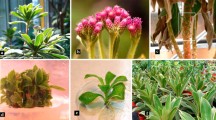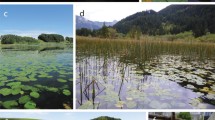Abstract.
Pancratium maritimum L. is an Amaryllidaceous species whose presence is severely endangered in its original range, the sandy coasts of the Mediterranean sea. A molecular analysis has been performed to evaluate the genetic distance among populations coming from different locations, in order to define the best repopulating strategy. The plant genome, analysed by AFLP markers, was found to be extremely homogeneous and conserved, evoking vegetative or autogamous reproductive habits. Seeds from two different locations showed a good germination capability in greenhouse tests, indicating the potential presence of an efficient sexual reproduction. The combination of molecular data and germination tests would support the hypothesis of an autogamous reproduction for this species.
Similar content being viewed by others
Abbreviations
- AFLP:
-
Amplified Fragment Length Polymorphism
References
G. Arcangeli (1896) ArticleTitleSulla struttura e sulla disseminazione dei semi del Pancratium maritimum Bollettino Società Botanica Italiana 1896 278–280
M.A. Cardoso J. Provan W. Powell P.C.G. Ferreira D.E. De Oliveira (1998) ArticleTitleHigh genetic differentiation among remnant populations of the endangered Caesalpinia echinata Lam (Leguminosae–Caesalpinioideae) Molecular Ecology 7 601–608
J.J. Doyle J.L. Doyle (1990) ArticleTitleIsolation of plant DNA from fresh tissue Focus 12 13–15
D. Eisikowitch L. Galil (1971) ArticleTitleEffect of wind on the pollination of Pancratium maritimum L. (Amaryllidaceae) by hawkmoths (Lepidoptera: Sphingidae) Journal of Animal Ecology 40 673–678
N.C. Ellstrand (1992) ArticleTitleGene flow by pollen – implications for plant conservation genetics Oikos 63 77–86
N.C. Ellstrand D.R. Elam (1993) ArticleTitlePopulation genetic consequences of small population size – implications for plant conservation Annual Review of Ecology and Systematics 24 217–242
D.R. Govindaraju (1988) ArticleTitleRelationship between dispersal ability and levels of gene flow in plants Oikos 52 31–35
L.F. Huenneke (1991) Ecological implications of variation in plant populations D.A. Falk K.E. Holsinger (Eds) Genetics and Conservation of Rare Plants Oxford University Press New York 31–44
A. Karp K.J. Edwars M. Bruford S. Funk B. Fosman M. Morgante (1997) ArticleTitleMolecular technologies for biodiversity evaluation: opportunities and challenges Nature Biotechnology 15 625–628
J.A. Leraut (1997) Liste systématique et synonymique des Lépidoptères de France Belgique et Corse Paris
M. Medrano P. Guitián J. Guitián (1999) ArticleTitleBreeding system and temporal variation in fecundity of Pancratium maritimum L. (Amaryllidaceae) Flora 194 13–19
M. Nei (1978) ArticleTitleEstimation of average heterozygosity and genetic distance from a small number of individuals Genetics 89 583–590
M. Nei (1987) Molecular Evolutionary Genetics Columbia University Press New York
V. Perez-Mellado F. Ortega S. Martin-Garcia A. Perera G. Cortazar (2000) ArticleTitlePollen load and transport by the insular lizard Podarcis lilfordi (SquamataLacertidae) in coastal islets of Menorca (Balearic Islands, Spain) Israel Journal of Zoology 46 IssueID3 193–200
C.E. Shannon W. Weaver (1949) The Mathematical Theory of Communication University of Illinois Press UrbanaIllinois
M. Slatkin (1985) ArticleTitleGene flow in natural population Annual Review of Ecology and Systematics 16 393–430
M. Slatkin (1987) ArticleTitleGene flow and the geographic structure of natural populations Science 236 787–792
M.E. Soule (1980) Thresholds for survival: maintaining fitness and evolutionary potential M.E. Soule B.A. Wilcox (Eds) Conservation Biology: An Evolutionary-Ecological Approach Sinauer Associates SunderlandMassachusetts 151–169
H.J. Thompson (1914) Flowering Plants of the Riviera A Descriptive Account of 1800 of the More Interesting Species. Longmans, Green & Co. London
S. Wright (1978) Evolution and the Genetics of Populations: Variability Within and Among Natural Populations Chicago University Press ChicagoIllinois
F.C. Yeh R.C. Yang T. Boyle (1997) POPGENE CIFOR Version 1.21 University of Alberta Canada
Author information
Authors and Affiliations
Corresponding author
Rights and permissions
About this article
Cite this article
Grassi, F., Cazzaniga, E., Minuto, L. et al. Evaluation of biodiversity and conservation strategies in Pancratium maritimum L. for the NorthernTyrrhenian Sea. Biodivers Conserv 14, 2159–2169 (2005). https://doi.org/10.1007/s10531-004-4666-0
Received:
Accepted:
Issue Date:
DOI: https://doi.org/10.1007/s10531-004-4666-0




